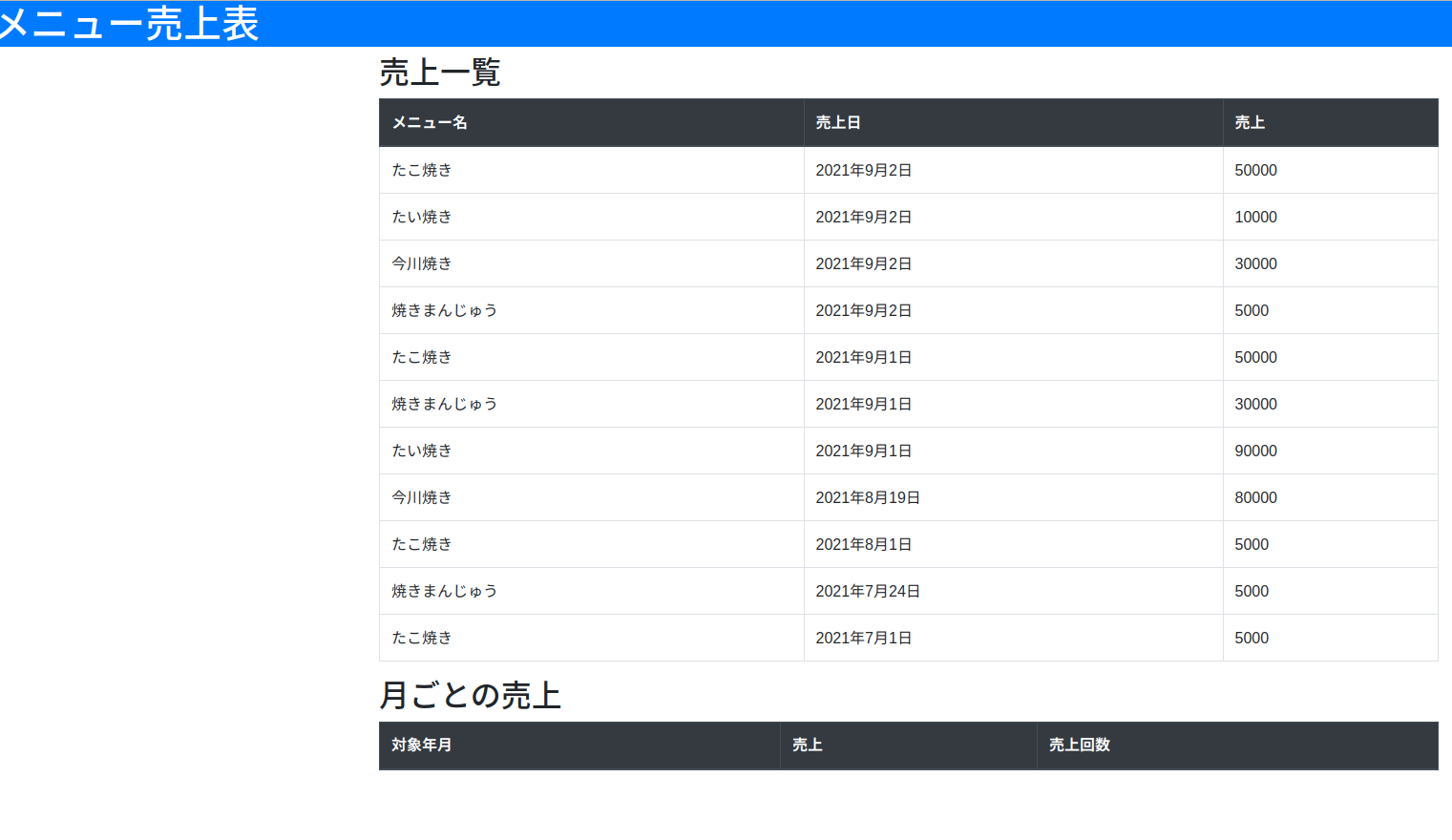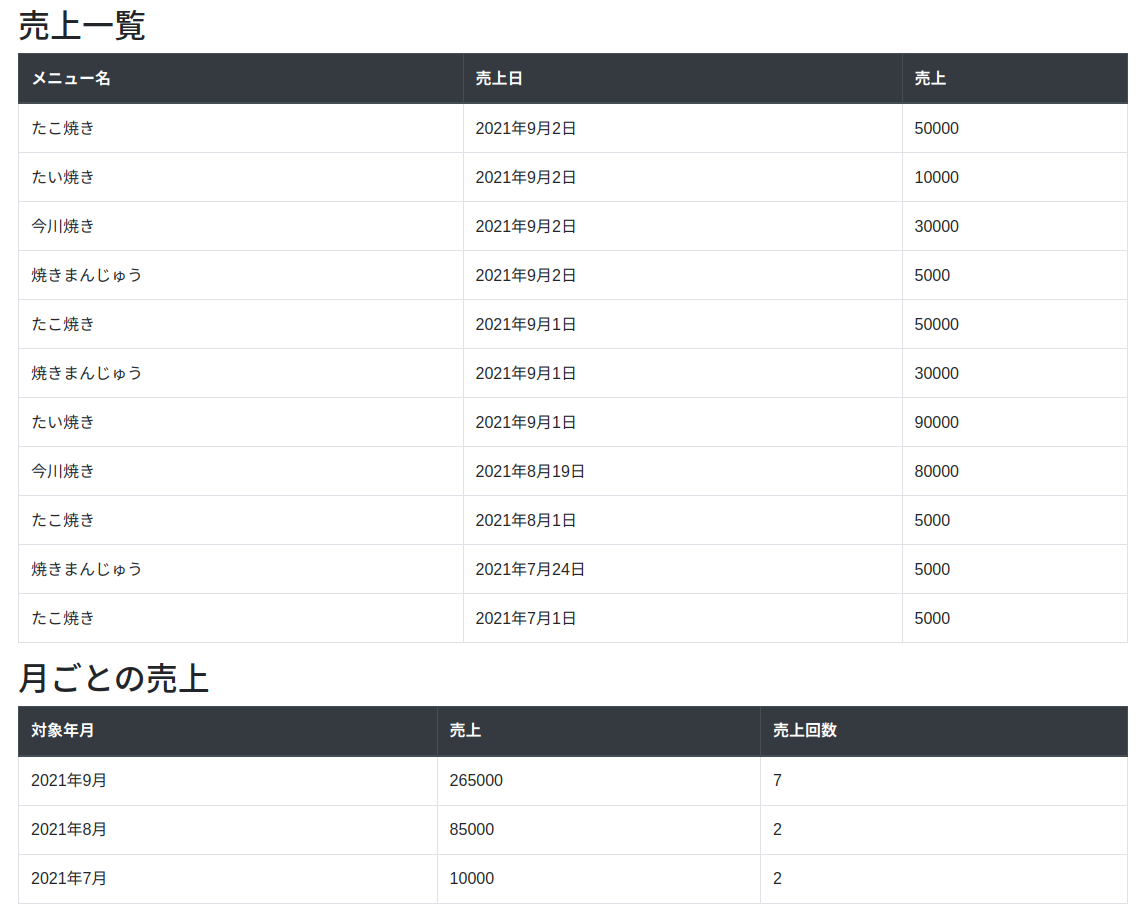【Django】年、月、日単位でデータをファイリングする時はTruncを使用する【月ごとの売上、個数などの出力に有効】

ブログなどでよくある、月別アーカイブ。経理でよくある、月ごとの売上記録、年ごとの収支。そういった計算をする時、annotateとTruncを使えば1行で出力できる。
ソースコード
モデルがこんな感じ。
from django.db import models
class Menu(models.Model):
class Meta:
db_table = "menu"
name = models.CharField(verbose_name="メニュー名",max_length=2000)
date = models.DateField(verbose_name="売り上げた日")
amount = models.IntegerField(verbose_name="売上金")
def __str__(self):
return self.name
データを入力して表示させるとこんな感じ。急造したためモデルとテーブルのヘッダ名がややおかしいが、要するにメニュー名と売上日と売上金が書かれてある。
それを、月ごとに売上金と売上回数を合計して表示させたい。

ビューはこうなる。
from django.shortcuts import render,redirect
from django.views import View
from .models import Menu
from django.db.models.functions import TruncMonth
from django.db.models import Count,Sum
class MenuView(View):
def get(self, request, *args, **kwargs):
menus = Menu.objects.all().order_by("-date")
monthly_menus = Menu.objects.annotate(monthly_date=TruncMonth("date")).values("monthly_date").annotate(
count=Count("id"),monthly_amount=Sum("amount")).values("monthly_date","monthly_amount", "count").order_by("-monthly_date")
context = { "menus":menus,
"monthly_menus":monthly_menus,
}
return render(request,"menu/index.html",context)
index = MenuView.as_view()
まず、annotateでフィールド追加する。TruncMonthで日付フィールドを指定、月ごとにまとめてmonthly_dateとして追加。その後、Count("id")で月毎に含まれているレコードの数をカウント、月ごとに売上金(amount)を合計し、それぞれcount、monthly_amountとしてannotateで追加する。
最後に、monthly_dateで並び替えを最新順に仕立てる。これで、月ごとの売上金、売上回数を表示できる。
テンプレートはこうなる。
<!DOCTYPE html>
<html lang="ja">
<head>
<meta charset="UTF-8">
<meta name="viewport" content="width=device-width,initial-scale=1">
<title>メニュー売上表</title>
<link rel="stylesheet" href="https://stackpath.bootstrapcdn.com/bootstrap/4.4.1/css/bootstrap.min.css" integrity="sha384-Vkoo8x4CGsO3+Hhxv8T/Q5PaXtkKtu6ug5TOeNV6gBiFeWPGFN9MuhOf23Q9Ifjh" crossorigin="anonymous">
</head>
<body>
<h1 class="bg-primary text-white">メニュー売上表</h1>
<main class="container">
<h2>売上一覧</h2>
<table class="table table-bordered">
<thead class="thead-dark">
<tr>
<th>メニュー名</th>
<th>売上日</th>
<th>売上</th>
</tr>
</thead>
<tbody>
{% for menu in menus %}
<tr>
<td>{{ menu.name }}</td>
<td>{{ menu.date }}</td>
<td>{{ menu.amount }}</td>
</tr>
{% endfor %}
</tbody>
</table>
<h2>月ごとの売上</h2>
<table class="table table-bordered">
<thead class="thead-dark">
<tr>
<th>対象年月</th>
<th>売上</th>
<th>売上回数</th>
</tr>
</thead>
<tbody>
{% for m in monthly_menus %}
<tr>
<td>{{ m.monthly_date|date:"Y年n月" }}</td>
<td>{{ m.monthly_amount }}</td>
<td>{{ m.count }}</td>
</tr>
{% endfor %}
</tbody>
</table>
</main>
</body>
</html>
動かすとこうなる

他にも売上の平均額などを算出したいのであれば、Avgを使うと良いだろう。そのままだと年月だけでなく日付(1日)まで表示するので、テンプレートで表示させたくない場合は、dateフィルタを使うと良い。
結論
これで月ごとの個数を計測し表示させることができる。もっとも最古と最新のデータを元に1月ずつずらしてループし.count()すれば実現出来なくもないが、コードが長くなる。
モデルのfunctionsは他にも関数があるようなので、覚えておけばビューの処理が大幅に軽減できそう。
問題点として.values()を使うので、モデルオブジェクトではなく辞書型になってしまうこと。外部キーで繋がっているデータをテンプレート側で参照したい場合、この方法では参照するデータを追加する必要がある。
https://stackoverflow.com/questions/8746014/django-group-by-date-day-month-year
https://docs.djangoproject.com/en/3.2/ref/models/database-functions/#trunc